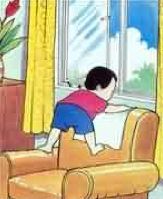Introduction
Falls are the most common home accident in Malaysian children. Children between ages 1 to 4 are more prone to falls. They are at risk because of their development stages and their surrounding environment.

Falls can happen anywhere :
- Within the home, example from :
- furniture
- staircase
- balcony
- baby walker
- Outside the home, example :
- at playground
- from rides
Injuries from falls
Following a fall, children may sustain various types of injuries such as :
- Soft tissue injuries such as bruises, sprain, cuts and abrasion
- Fracture – swollen, pain and deformed limbs
- Head injury – swollen scalp, bleeding from the ear, nose and mouth, sleepy, vomiting, fits and loss of consciousness
- Internal organ injuries
Serious consequences from falls
- Permanent brain injury, stunted growth if fracture involved growth plate of the bone.
- Severe injuries may result in permanent organ damage and /or death.
Treatment
- The treatment depends on the types and severity of the injuries.
- If the child sustains minor injuries such as bruises and sprain, cold compress the area with ice. Give the child paracetamol syrup to relieve pain. Rest the affected area.
- If the child sustains cuts, clean the area with water, compress the wound with your thumb for few minutes to stop bleeding and elevate it. Cover it with clean dressing.
- If you suspect the child has a broken bone, splint the area with a blanket, thick cloth or pillow to avoid movement. Use a cloth sling for any broken bones of the upper limbs.
- Check the bandaged areas to ensure normal blood circulation. If the skin becomes cold and discoloured, loosen the applied bandage.
- If you suspect the child to have serious injuries, seek medical help.
Prevention
Majority of falls are preventable. These are some steps to prevent falls :
Stairs
- Block both the head and foot of the stairs or the house doors.
- Ensure that all stairs are well lit.
- Make sure children are not left unattended on an upper storey, balcony or any other high places.
|
Floors
|
 |
Furniture arrangement
- Avoid placing chairs and furniture near windows.
- Wash bathroom regularly to prevent moulding which causes slippery floor.
| Last reviewed | : | 23 August 2019 |
| Writer | : | Dr. Norraliza bt. Md. Zain |
| Reviewer | : | Dr. Mohamad Hamim b. Mohamad Hanifah |







